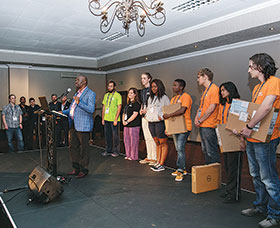Supercomputing students bring home third prize
18 July 2018
Editor's Choice
News

The South African supercomputing team that participated in the International Student Cluster Competition in Frankfurt, Germany, took third place behind China’s Tsinghua University and Nanyang Technological University of Singapore.
The team of six, made up of undergraduate computer science and engineering students from the Universities of the Witwatersrand and Limpopo, was one of 12 teams from around the world that participated in the prestigious challenge from 25 to 27 June 2018.
The students showcased computing systems of their own design, adhering to strict power constraints and seeking to achieve the highest performance across a series of standard high-performance computing benchmarks and applications. South Africa has been participating in the international competition since 2013 and won it in 2013, 2014 and 2016, coming second in 2015 and 2017. It is one of the few teams that consists entirely of undergraduate students, and that sends different students each year.
Before participating, the members of the team received extensive training from the Centre for High Performance Computing (CHPC), an initiative of the Department of Science and Technology and the Council for Scientific and Industrial Research (CSIR).
The CHPC’s Director, Dr Happy Sithole, said that the placing was “a significant achievement for South Africa,” and that the CHPC hopes to increase the number of students who received exposure of this kind in the field of high-performance computing. “In the past six years we have had 36 students performing well on the world stage,” he said.
The South African team was chosen from 10 participating teams at a national student cluster supercomputing competition held in December last year. Team selection for the national competition takes place at the CHPC’s Winter School, which is designed to impart critical knowledge for building a cluster. This includes using Linux systems, the basic software stack of a cluster, and considerations that should be taken into account when choosing hardware. Team selection concludes with an assignment that requires each team to build a prototype cluster in the cloud.
After all their hard work, this year’s team – Meir Rosendorff, Joshua Bruton, Kimessha Paupamah, Katleho Mokoena, Nathan Michlo and Njabulo Sithole – said that they planned to hire bicycles and cycle around Frankfurt “doing touristy things”.
For more information contact Nox Moyake, CHPC, [email protected]
Further reading:
The trends driving uptake of IoT Platform as a Service
Trinity IoT
Editor's Choice Telecoms, Datacoms, Wireless, IoT
IoT platforms, delivered as a service, are the key that will enable enterprises to leverage a number of growing trends within the IT space, and access a range of benefits that will help them grow their businesses.
Read more...
Interlynx-SA: Engineering SA’s digital backbone
Interlynx-SA
Editor's Choice
At the heart of the industrial shift towards digitalisation lies the growing demand for telemetry, Industrial IoT (IIoT), advanced networking, and robust data solutions, and Interlynx-SA is meeting this demand.
Read more...
Converting high voltages without a transformer
Altron Arrow
Editor's Choice Power Electronics / Power Management
With appropriate power converter ICs, such as the LTC7897 from Analog Devices, many applications can be suitably powered without having to use complex and cost-intensive transformers.
Read more...
Grinn Global: From design house to SoM innovator
Editor's Choice
From its beginnings as a small electronic design house, Grinn Global has moved into the spotlight as a system-on-module innovator working alongside technology giants like MediaTek.
Read more...
Active event tracking using a novel new technique
Editor's Choice
SPAES (single photon active event sensor) 3D sensing, developed by VoxelSensors, is a breakthrough technology that solves current critical depth sensing performance limitations for robotics applications.
Read more...
ABB commits to a more inclusive future as it empowers women and youth in engineering
ABB South Africa
Editor's Choice
Through structured development, inclusive hiring, and focused empowerment, ABB Electrification is shaping a more equitable and dynamic future for the engineering industry.
Read more...
Unlocking the next frontier – women leading digital transformation in South Africa’s technology sector
Editor's Choice
As South Africa celebrates Women’s Month, it is an ideal time to reflect on the critical role women are playing in shaping the country’s technology sector.
Read more...
Why GNSS positioning precision is enabling the next wave of IoT applications
iCorp Technologies
Editor's Choice Telecoms, Datacoms, Wireless, IoT
While high-performance GNSS implementations are achievable with few limitations, most real-world applications must balance power consumption, form factor and accuracy requirements.
Read more...
5G RedCap: Unlocking scalable IoT connectivity
iCorp Technologies
Editor's Choice Telecoms, Datacoms, Wireless, IoT
As 2G and 3G networks rapidly sunset across the globe, the Internet of Things (IoT) market faces a critical challenge: how to maintain reliable cellular connectivity without the complexity or cost of full 5G.
Read more...
Is RFoIP technology the future for signal transportation for Satcom applications?
Accutronics
Editor's Choice Telecoms, Datacoms, Wireless, IoT
RFoF technology continues to be used for successful IF signal transportation in the ground segment and there is widespread belief that it will be for some time to come, especially for critical communications applications.
Read more...


